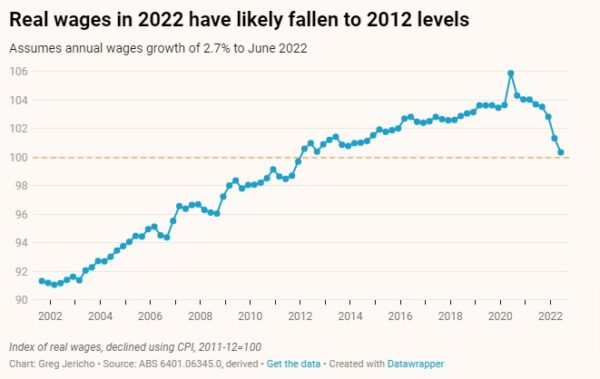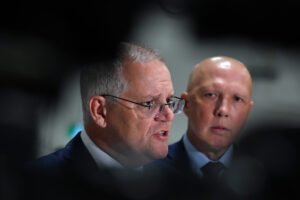The latest inflation figures from the Bureau of Statistics reveal just how much workers have been left behind. Writing in Guardian Australia, labour market and fiscal policy director Greg Jericho notes that while the focus is on the biggest annual increase in inflation since the introduction of the GST, the data also shows that real wages have fallen drastically.
Given prices grew 6.1%, but wages are expected only to achieve around 2.7% growth in the 12 months to June, it remains abundantly clear that inflation is not being driven by labour costs. Indeed given real wages have likely fallen around 3.4% in the past year, wages are currently extremely deflationary.
Real wages have now fallen for 8 consecutive quarters sending the purchasing power of employees back to 2012 levels.
While the economy has rebounded and profits have risen strongly with that of prices, the “recovery” from the pandemic has very much been on the backs of workers who have effectively lost a decade’s worth of growth in real wages.
Even worse, given the greatest price rises have occurred for essential commodities, it is clear low to median income workers are hurting much more than those who devote less of their spending on essentials than does the average household.
All this is occurring with unemployment at near 50-year lows. It is now abundantly clear that the labour market systematically disempowers employees and needs to be reformed.
You might also like
Reversing years of lost power: the real reason behind Australia’s dismal wage growth
New research has revealed that real wages have been held back in Australia in recent decades because workers’ power to negotiate has been persistently and consistently eaten away.
Productivity is often mistaken for wages. What does it really mean? How does it work?
Australia’s productivity growth has reverted to the same stagnant pattern as before the pandemic, according to the Productivity Commission’s latest quarterly report. Productivity is complex and often misunderstood in media and policy debates. So before we read too much into this latest data, here are six key things to understand about productivity. 1. It’s about quantities,
The continuing irrelevance of minimum wages to future inflation
Minimum and award wages should grow by 5 to 9 per cent this year





